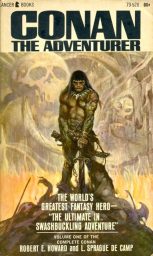
Greatest Cover Ever!
I came across this article about men’s fiction that men account of 20% of fiction sales. I found a Publisher’s Weekly article on Hot and Cold Book Categories of 2015. That article showed a 12% decline in science fiction and fantasy from 2014 to 2015.
I have been reading science fiction and later fantasy since the middle 1970s. Most people from middle 40s on up you talk to that read don’t seem to enthusiastic at the selections available on shelves.
It goes back to the basic rule of business of creating new customers. It used to be the classic new customer was the age range around 11-14. Talk to anyone over 50 and chances are they got started reading Edgar Rice Burroughs (like me), Howard, Lovecraft, Asimov, Heinlein, Clark etc.
In the 1970s, you could find most of these authors. Depending on where you lived, you might have picked up these books at the grocery store, drug store, department store. K-Mart used to have a very nice book department at one time.
If we want our favorite sub-genres to survive, we need new readers. I will make the case we need to bring back the male readers.
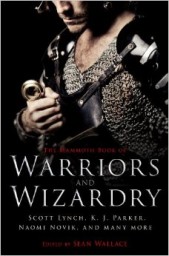
Fabio was here
That means publishing fiction that is going to appeal to males.
When I was 12 or so, I wanted to read about space armadas and big space battles. I just don’t remember seeing all that many. I wrote a long series about sword and sorcery artists last year. Fantasy is where the covers grabbed your attention.
The covers today are less than thrilling. Static photoshopped poses are anti-climactic to one who remembers Frazetta, Jones, Whelan etc.
The fiction- years ago I had the belief there was a market for a magazine that was action oriented with contents that were space opera, sword and sorcery, action horror, and even lost race. The time for fiction magazines might be passed, at least in print form. Annual anthologies are probably a more viable form borne out by Baen Books’ Year’s Best Military & Adventure SF series that will have a fourth volume out in a few months.
I belong to a Yahoo group wherein editor/writer Mike Ashly once made a comment that the Clayton era Astounding Stories of Super Science was unfortunately the first of action science fiction that would live on in Planet Stories. There is room for action science fiction, you want readers for other sorts of science fiction, prime the pump. I happen to like Planet Stories. I have a near complete run of the magazine.
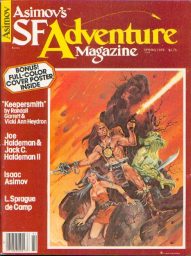 There was an attempt to publish an action adventure science fiction magazine (in theory) in the late 1970s with the oxymoronic title of Asimov’s SF Adventure Magazine. It lasted for four issues. There were a few memorable stories but the magazine but it really failed to capture adventure consistently.
There was an attempt to publish an action adventure science fiction magazine (in theory) in the late 1970s with the oxymoronic title of Asimov’s SF Adventure Magazine. It lasted for four issues. There were a few memorable stories but the magazine but it really failed to capture adventure consistently.
It is like the periodic attempt to resurrect Unknown. Editors and critics seemed obsessed that there are legions of readers hammering at the door to get snarky, smart-ass, sneering fantasy that is at the end of the day, Bewitched. Unknown lasted for four years. Yes, a paper shortage killed it but John Campbell chose not to revive it. He realized it was a one trick pony where the joke got old fast. Yet, some editor gets it in his head to revive the idea. Despite the nostalgia, that sort of fantasy does not age well and does not have an audience to sustain such a publication.
The advent of the e-reader is making changes. We might see the return of the novelette, novella, and short novel. The would be gate-keepers can be bypassed. Yet, you have to be looking for the fiction to begin with. How many of you discovered a favorite author or book by accident seeing it on the shelf?
I saw an article that e-reader sales have flat lined. Readers still like the feel of paper. This gives me hope for the mass market paperback. I hate trade paperbacks. They are a bastard child created by university presses in the 1950s to distance themselves from the lowly mass market paperback. The spines crack easily, the corners get bent or damaged. The rush to trade paperbacks strikes me as a cynical move to charge more for a book that could have been a mass market paperback.
Want new readers? Get back to mass market paperbacks. Keep the price down. Western writer James Reasoner once said to me that a paperback should cost about one hour at the minimum wage. That keeps the paperback within the impulse buy range. Those trade paperbacks are less likely to compete for a 14 years old discretionary income.
Publish fiction that teenage boys will read. Space opera, fantastic adventure, sword and sorcery, action horror. They are not going to want to read some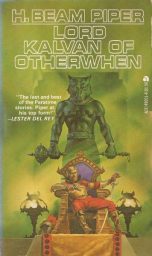 navel gazing philosophical tract. There should be things going on, not lots of dialogue. Don’t make the fiction too clever for its own good.
navel gazing philosophical tract. There should be things going on, not lots of dialogue. Don’t make the fiction too clever for its own good.
Don’t be afraid of classics including Edgar Rice Burroughs, Jack Williamson’s “Legion of Space,” Poul Anderson, Robert E. Howard, or even Harold Lamb.
For Crom’s sake, get rid of the photoshopped poses and bring back dynamic cover art.
Get the books to places outside of Barnes & Noble and Books A Million. There is opportunity waiting for someone to recreate the mid-list distribution system. Get those books in grocery stores, truck stops, mini-marts, comic-book stores etc.
If men make up only 20% of the fiction reading audience, there is opportunity. It used to be in used bookstores, you did not see much Louis Lamour paperbacks in the western section. Now I notice whole shelves. The readers are dying off and the survivors/executors are getting rid of the deceased paperbacks. This could happen with classic science fiction and fantasy.
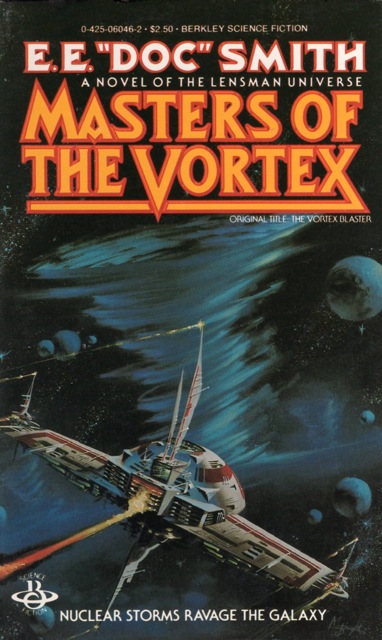
Honestly before Castalia House came along, I bought virtually no new fiction. Even now, the vast majority of newly published books I buy are non-ficiton. I do read a lot of fiction too but mostly the classics. The newest fiction books I bought as a young adult were Bernard Cornwell novels and stuff like that.
It isn’t just that the covers are bad, the prices are high and the books aren’t aimed at men though. The vast majority of modern fiction is just awful anyway. There are plenty of exceptions of course but prior to Castalia, I only found such books through word of mouth. You’d never see them in a bookstore.
Morgan.
A great and impassioned call to revive the pulps. I’m not against mass print paperbacks but it needs to part of an ecology: ebooks, audiobook comic books even video games.
Give male readers lots of options
xsvier
Bring back Mass Market Paperbacks and dynamic covers. YES!
The compact size and action packed art will draw the attention of any male who wants a good time. Right now covers are all about photoshopping bored people standing around and looking cool.
I can’t stand it. All the adventure is gone!
Might want to check your priors. The ROK article just links to NPR from over a decade ago. In the last decade, ebooks and self-publishing writers putting out books men like have changed the game considerably.
http://www.pewresearch.org/fact-tank/2016/11/23/who-doesnt-read-books-in-america/
That says 69% of men have read a book in the last year (2015 for a 2016 survey) and 79% of women.
Also, even in the NPR article that is real source of this factoid, men read 5 books per year on average 10 years ago to women’s 9.
The NPR piece doesn’t break down what they mean by “men are 20% of the fiction market according to surveys”, and even before ebooks and self-published ebooks, there were active small presses putting out fiction for men that wouldn’t have shown up in survey data.
Also, romance superreaders are a confound. They represent very very very few women, but they are highly engaged readers who read as many as 1000 books per year and purchase hundreds per year.
I think the market has been steadily providing male-friendly fiction prior to and including Castalia’s offerings because that appears to be the case.
Plus, you know, gaming supplements and other game-related storytelling that is technically fiction and often purchased but would never make a survey about what fiction men read.
-
Romance readers do consume paperbacks like few others. I can remember in the late 1980s, used bookstores on the west side of Cleveland, OH, run by aging women who had the store to subsidize their habit. Getting a percentage of male readership is slippery depending on how you parse it. My point is getting the boys age 12-15 in the habit of reading. Plus reading old fiction is a good antidote to the indoctrination that goes on from K through 12.
Most millennials are too stupid too read. They grew up under Obama and iPhones . It’s a safe bet that 80% are entitlement-freak SJWs and the other 20% are video-game playing porn-watching morons. They’re hopeless.
If you want to cultivate the next generation of SFF readers, you should be targeting Generation Z. With the youth, there is still hope.
Amen, with regards to the covers.
As Nick Cole spoke about recently, Covers matter, no matter how much people want to claim otherwise.
However, I may be the lone dissenter when it comes to Trade Paperbacks. I don’t seek them out but if I can find one at the book store or on Amazon, I will often choose it over the mass market book.
I just find them easier to read, both on my eyes (since the fonts are sometimes larger, even a little bit) and they are easier to hold open.
But that’s just me.
Thanks so much for the post.Really thank you! Keep writing.
A worthwhile and worthy cause and one I support but ultimately a forlorn one I fear. Availability and accessability are only part of the problem. Our generation simply didn’t have the techno and social media distractions that kids have today. Mind you, we were compensated with greater attention spans.
That’s not to say that Am*z*n still aren’t shamefully culpable for destroying so many venerable book chains and – more importantly – so many of the smaller outlets where so many book collecting habits of our day began. When I was turning into my teens a lot of my preferred reading – cheap schlock horror mostly and fantasy – came from the carousels in the local newsagents. The books were cheap and convenient; easy to pick up on the way home from school. Nowadays the only place you see such things here in the UK are post offices, and what sort of kid has ever voluntarily walked into a post office? Most teenagers today probably don’t even know what post offices are.
Publishers haven’t helped themselves either by making modern books so dull to look at. I read very little modern fiction and its not because I don’t rate new writers in comparison with old ones. But go into somewhere like Forbidden Planet and you’re confronted with walls of identically packaged homogenous pap. How is anyone expected to find something to catch the eye when every book looks indistinguishable from another. They even boast interchangeable blurbs and the same old tired endorsements (from Neil Gaiman usually). No, give me a second-hand bookshop any day with the characteristic quirks of a Mayflower, Sphere, NEL or Magnum paperback and PAJ, Pennington, Acilleos or Foss covers to sell them to me.